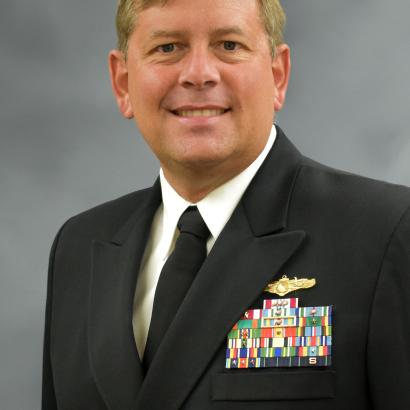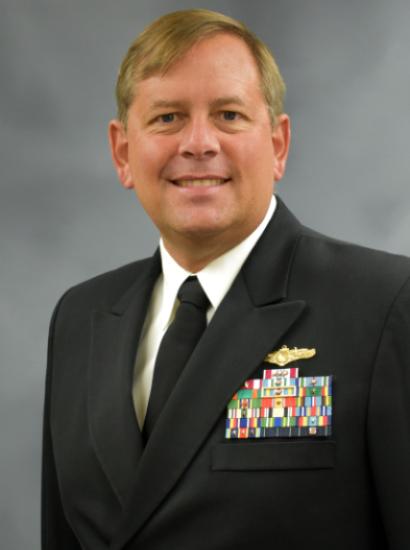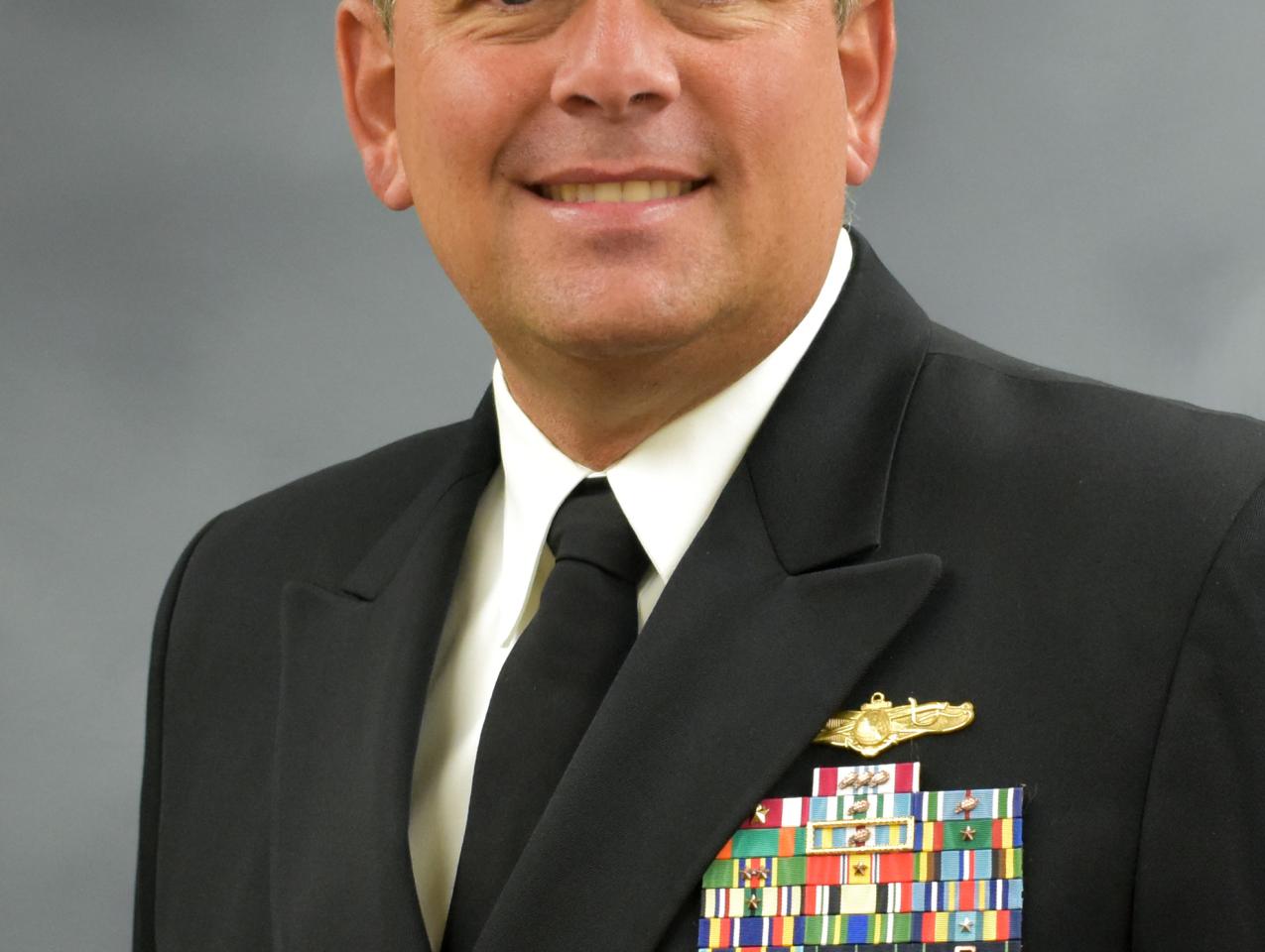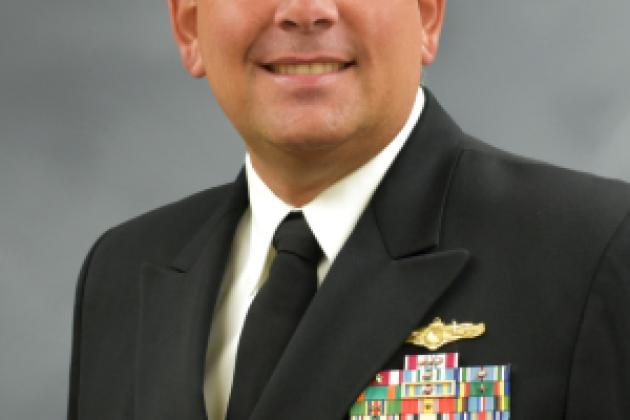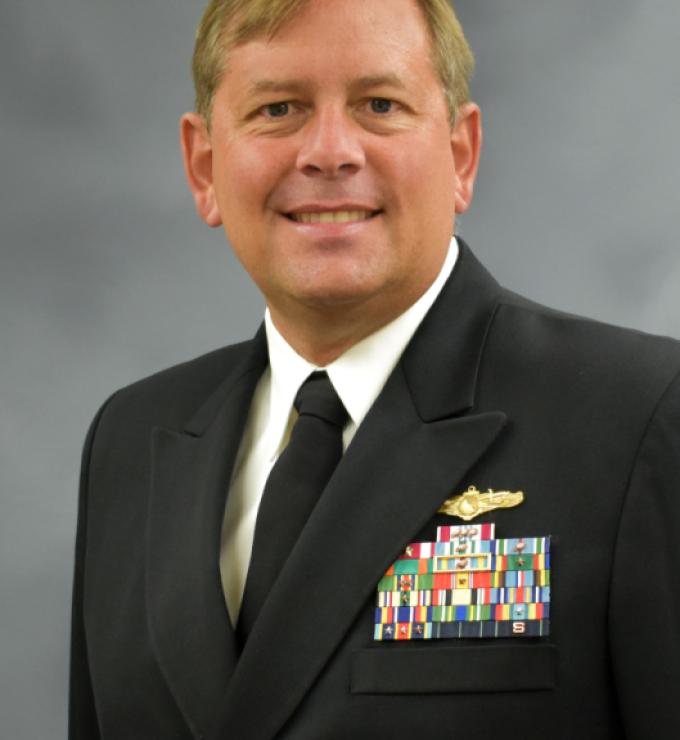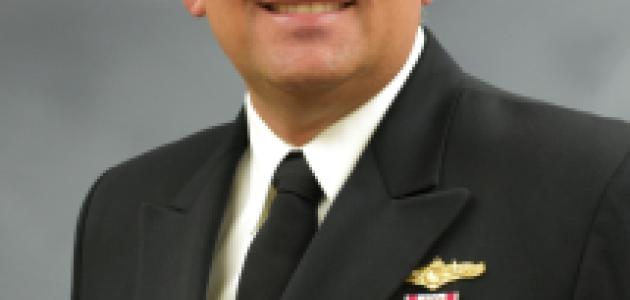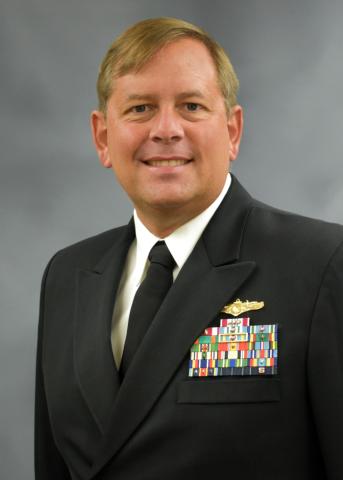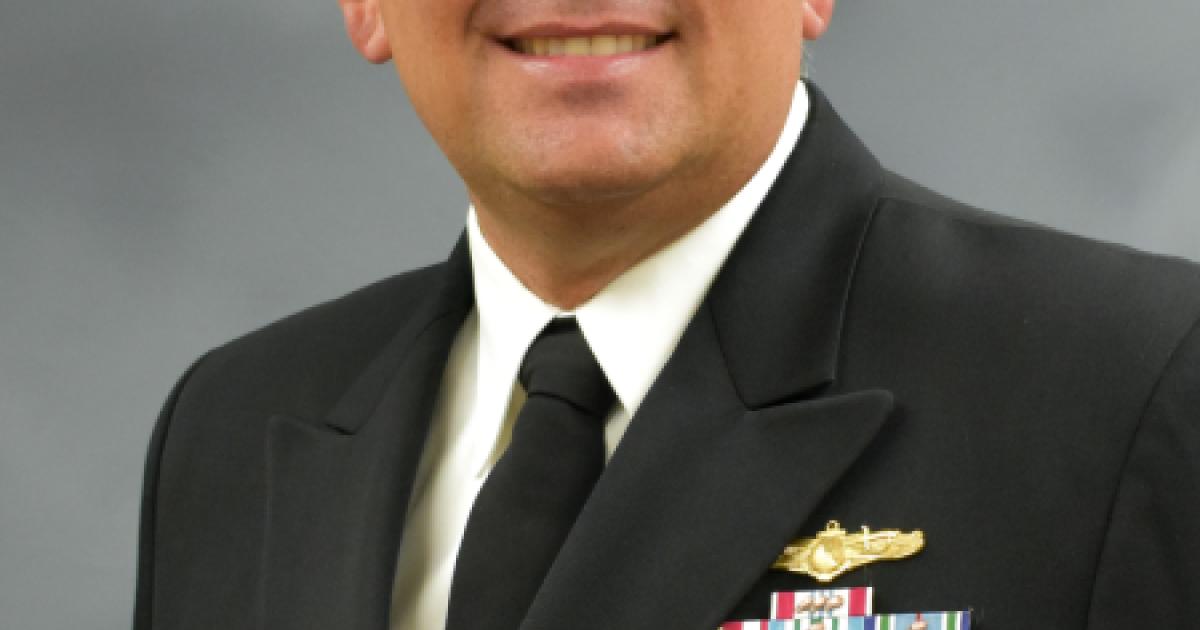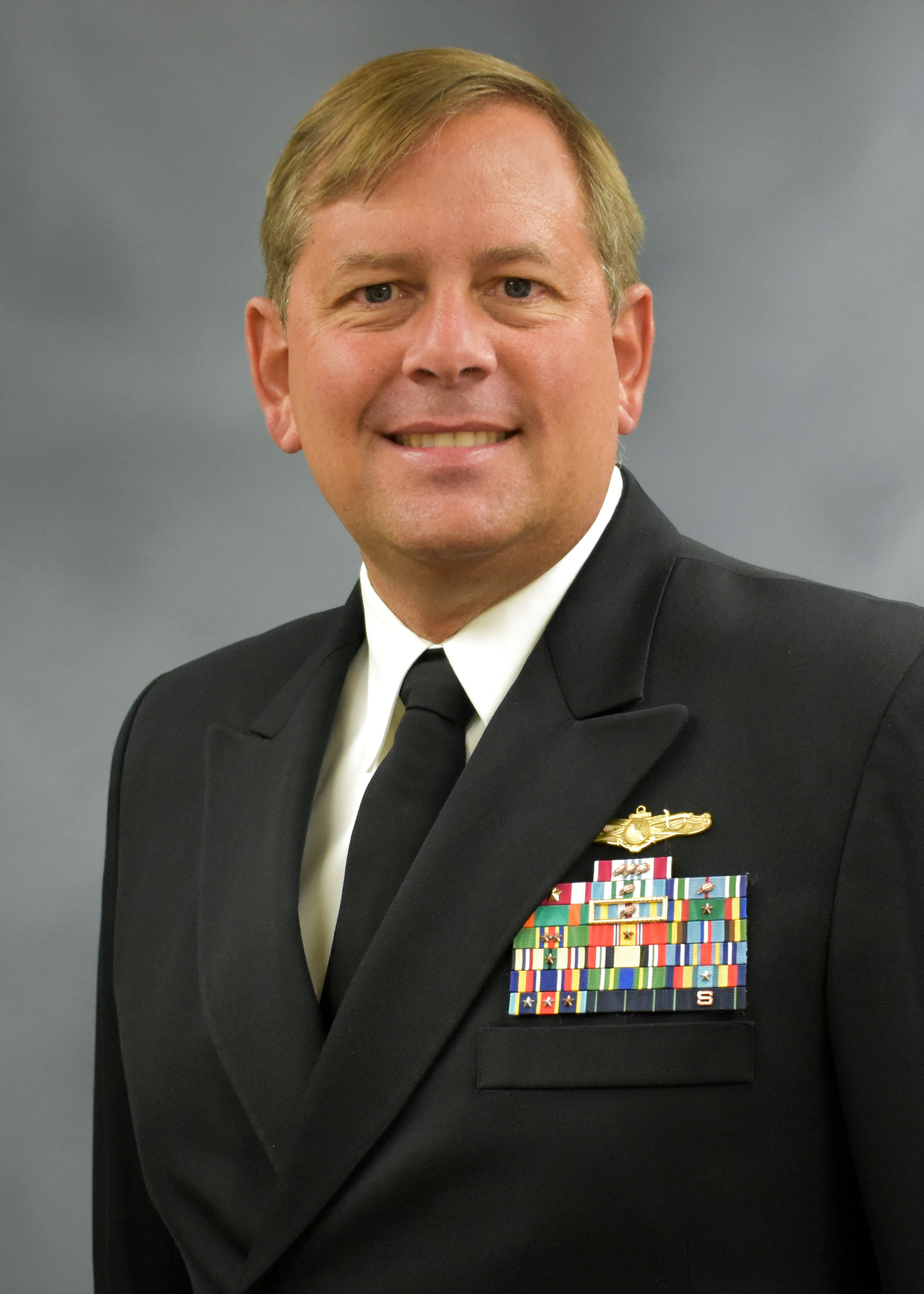
by Jonathan Movroydis
Captain Christopher H. Sharman, representing the US Navy, is a National Security Affairs Fellow for the academic year 2019–20 at the Hoover Institution.
In this interview, Sharman discusses his development as a US Navy intelligence officer, his work as a naval attaché in China and Vietnam; and how China’s naval forces measure up to those of the US Navy. His views are his own and do not reflect the official policy or position of the US Navy, US Department of Defense, or the US government.
How did you choose a career in naval intelligence and a specialization in Asia’s maritime security?
I attended the University of California–San Diego and participated in the school’s ROTC program. My calling to the Navy came after I watched the movie Top Gun. I wanted to be a fighter pilot. My plan was to commission as an officer following graduation and attend flight school in Pensacola, Florida. However, when I arrived to start flight school, I scored a nine out of ten on the color-blindness test, and could not fly without a perfect score. They thanked me for my interest in naval aviation and told me to find another job. That led me to intelligence.
At UCSD, I had a language requirement for my political science major. I wanted to focus on a language that fewer students were studying, so I studied Japanese. I also attended several courses focused on Asia. I really enjoyed studying about Asia, because it's a bit like the Wild West. Europe is a great place to visit, but it's very comfortable. I wanted to do something new. I wanted to explore an area that would push me outside my comfort zone. I didn't know that I was going to be an Asia specialist. I just kind of developed this interest over time.
When I was commissioned as a navy officer, the Soviet Union had just fallen apart. There were a lot of smart people in the intelligence community who were still Russian and Soviet experts, but virtually nobody was focused on China. There was no point in becoming an expert on a defunct country, so I chose to focus my career on Asia.
My first operational tour was on the USS Independence from 1994 to 1996. At the time, the first island-wide democratic presidential elections in Taiwan were about to take place, and polls showed an advantage for the leader that favored greater Taiwan independence, Lee Teng-Hui. Taiwan’s democracy made the People’s Republic of China nervous. Thus, the PRC began launching missiles into waters close to Taiwan to intimidate and dissuade voters from casting their ballot for Lee.
As this crisis was taking place, the commander of the US battle group in charge of the aircraft carrier I was aboard was Admiral James Ellis, a current distinguished visiting fellow at the Hoover Institution. I observed ship and submarine movements in real time, and became fascinated with this military activity in what was then a critically important, but largely unreported, part of the world.
A couple of years later, I attended Naval Postgraduate School in Monterey and enrolled in a master’s program in national security affairs with follow-on language training at the Defense Language Institute. I decided to continue my studies in Japanese and completed my master’s thesis on Japan’s nuclear options. Although Japanese was a challenging language, I stayed clear from learning Chinese, because I saw how difficult it was for my peers.
Years later, I was selected to serve as the naval attaché in China. I was thrilled. There was one caveat: I had to go back to school and learn Chinese. And so I did, and became fluent.
I guess I am a glutton for punishment, because then I applied for another attaché job in Vietnam. And my boss said, “Guess what, you have to study Vietnamese now.”
As our national attention shifted to the Middle East in the early 2000s, my focus remained on Asia. When the Obama administration made its much-publicized “pivot to Asia” in 2012, I already had developed my expertise on China and other parts of the region.
What are the duties of a naval intelligence officer?
Naval intelligence is one of the 17 divisions of the greater intelligence community under the Office of the Director of National Intelligence. By its nature, naval intelligence primarily collects and analyzes information on potential maritime threats. A US naval intelligence officer surveys everything from the movements and capacity of an adversary’s navy to air power and ground-based missile systems that could threaten maritime forces.
A unique aspect of US naval intelligence is that it supports a force that is constantly on deployment and engaged globally. As a result, it tends to have more of a global and strategic focus than the other service branches. Even as a junior officer, I was able to focus on the developments and threats of an entire region. In contrast, Army intelligence officers at the same rank are more focused on activity of a single country below the corps level, including troop movements of opposing forces.
There are all sorts of feeds of intelligence such as electronic intelligence (interception and identification of electronic emissions), signals intelligence (interception of communications), and imagery intelligence (collected from overhead sources). Naval intelligence focuses on operational intelligence, that is, to collect information from these various feeds, put them together, and advise our commanders on what is happening to allow for better decision making.
All of my operational tours have been on ships based out of Japan. This is an important theater for US naval operations because we are constantly dealing with real-life crises and planning for real-world contingencies.
Where have you been deployed?
I have mainly served in the Seventh Fleet, which operates in the western Pacific on aircraft carriers such as the USS Independence, the USS Kitty Hawk, and the Seventh Fleet command ship, the USS Blue Ridge.
These were all based in Japan and part of the Forward Deployed Naval Forces. Ships based in the United States go through significant amounts of training before a large deployment to someplace like the Middle East. In contrast, Japan-based ships are always on the go, and thus deployed all the time. In a given year, there were periods of time when I spent at least 50 percent of my time away from home port aboard ships.
While most of my deployments have been throughout East Asia, I also served during the Second Persian Gulf War in 2003, aboard the USS Kitty Hawk for major combat operations in Iraq. Our ship provided aircover over US Army ground forces. In 2006, I was detailed by the Defense Intelligence Agency to Baghdad.
What are the principal differences between serving as a naval attaché in China and Vietnam?
I was the US naval attaché to the People’s Republic of China from 2009 to 2012. I was responsible for representing US military interests, supporting the US-China military relationship, and advising Washington about the activity of China’s military.
It was a challenging job but very rewarding. While I enjoyed my three years in Beijing, by 2012 I was ready for my next assignment.
By serving in China, it was very helpful for me to learn the Communist organization, decision-making process, and structure. The biggest difference between the two countries is that in China, the military relationship was reciprocity based, which made for a very tense environment and made it difficult to advance bilateral military relations. On the other hand, the Vietnamese were much more pragmatic and wanted to find a way to advance the US-Vietnam military relationship.
The US Embassy in China is a very large compound. There is a total of 14 military attachés led by an admiral or general. The embassy in Vietnam is much smaller. There were only five military attachés. My boss, the defense attaché, wore the same rank as me. The other service branches also had only one attaché. This allowed to me to have a lot more face time with the ambassador, with whom I would visit senior government officials and other leaders, and thus have more influence on policy.
My experiences in China and Vietnam were similar in that both were communist countries with the same red tape I had to navigate. Each had restrictions on access to and engagement with their military. Both countries had their “barbarian handlers.” When I went to interact with their military members, I was always accompanied by a handler from their respective defense ministries, as there was a common concern about interactions with foreign officials.
The overall objective of my attaché work was to advance US foreign-policy objectives and enhance bilateral military-to-military relationships. My assignment entailed building trust, resolving differences, and finding areas where the US military could work with the host country. These military channels help us gain an understanding of the capabilities, limitations, concerns, and ambitions of our counterparts. With information we obtain from interacting, we can inform policy makers in Washington to help them make better policy decisions.
The dynamics of the US-Vietnamese relationship is a bit of a paradox in that Hanoi is trying to improve its relationship with Washington without upsetting Beijing. As a consequence, the US will never be an official ally with Vietnam, because such an arrangement would provoke Beijing.
In 2014, China deployed an oil rig and began drilling in Vietnam’s territorial waters. This exacerbated Vietnam’s traditional distrust of China. While both countries’ governments share a communist ideology, they also have an adversarial history. China occupied Vietnam for about a thousand years. In 1979, China actually invaded Vietnam just a few years after supporting Hanoi in their war against the United States and South Vietnamese forces.
Vietnam responded to the 2014 incident by deploying maritime forces to resist what it viewed as an act of Chinese aggression. This was a key event, because it caused Vietnam to begin to hedge in favor of deepening relations with the United States. Among Vietnamese citizens, the United States has a favorability rating of over 90 percent.
When I was the naval attaché in Vietnam, my work involved advancing mutual interests with military leaders through cooperative partnerships that wouldn’t draw ire from Beijing. Much of my role also included informing policy makers in Washington on the best practices of managing this delicate relationship with Hanoi.
How has the PLA [People’s Liberation Army] Navy expanded in recent years?
China’s navy expanded the scope of their operations further from shore in the mid-1990s. Before this time frame, Chinese vessels rarely ventured outside their own waters. Their ship’s evaporators could not produce enough potable water for their sailors, who brought their own supply on board. As their supply ran low, the ships had to return to port.
Today, the Chinese Navy is operating around the world. Their ability to expand operations globally in just a few decades is impressive. Their weapons systems on their ships have also improved tremendously. China’s navy represents a formidable threat, and their capabilities need to be considered when the US Navy is operating in nearby waters.
The strategic challenge that China’s navy faces is that operational commanders have little autonomy. Commanding officers have minimal operational freedom and are dependent on Beijing for combat orders. By contrast, US naval commanders have a high degree of operational independence, which enables them to adapt quickly in conflict situations. These differences give the US Navy a tactical and operational advantage.
You won the 2015 National Defense University President’s Award for excellence in writing. What are the qualities of an excellent writer?
I wouldn't classify myself as an excellent writer. However, I do like to write, how is that? Military officers are busy with operational requirements, and there is so little time to think deeply on important issues. Taking time to write is important, because Americans need to know the challenges we face in Asia. Writing from the perspective of an active-duty officer lends credibility to security-related topics and can help to explain the military’s role in addressing strategic challenges and advancing our national interests in the region.
In 2015, I attended National Defense University in Washington, DC. This sabbatical from operational assignments gave me a chance to step back from the daily grind and consider a broader perspective on events I had observed in the Indo-Pacific region.
I focused my study on the Chinese Navy from 2004 to 2015. I compared their published maritime strategy to the activity we were witnessing. The official strategy of the Chinese Navy was a “near-seas active defense” of the mainland. In practice, however its naval vessels were operating in the “far seas,” beyond the second island chain in the Philippine Sea.
I predicted that the PLA Navy would modify its official naval strategy to become more consistent with its operations. And lo and behold, soon after I published my monograph, Beijing announced a new maritime strategy. In the course of my research, I was able to leverage my language skills by collecting and studying articles written in Chinese and Japanese. I also tracked every single PLA Navy deployment out of local waters and analyzed its objectives and capabilities, and determined what this meant for the future of the region. My research became the basis for a 50-page monograph, which concluded that China’s objective is to have a navy capable of deploying around the world.
What are your research goals at the Hoover Institution?
I am generally focused on how US policy can more effectively counter China’s aggression. This includes preventing China’s military expansion in the South China Sea; how the US should engage diplomatically with the other countries in Asia; and how best to advance US interests and maintain competitiveness with China in the region.
For example, I am focused on how the ten ASEAN (Association of Southeast Asian Nations) countries and China are engaged in what is called a Code of Conduct for operations in the South China Sea. This is a series of discussions that has been going on for years with the objective to stop small incidents at sea from escalating into larger conflicts. Over the last several years, China has built islands in the South China Sea that operate as military bases, and have claimed most of the South China Sea by drawing a “nine-dash line” on their official political maps. In negotiations with ASEAN, the Chinese have constantly deferred discussions about the Code of Conduct, telling their counterparts, “We’ll talk about it in the future.” Now that the Chinese have accomplished their objectives in the region, they appear ready to talk. Suddenly, these Code of Conduct discussions have a new fire.
The most recent ASEAN-China communiqué states that the two sides want to complete the Code of Conduct in the next three years. From the US perspective, that sounds good. We want peace and stability in the region. However, the problem lies in that China is trying to dictate the contents of the Code of Conduct in a way that is antithetical to US interests. They are trying to ban US petrochemical companies from the region, and China also wants to have veto power over all military exercises between ASEAN nations and foreign partners. When an ASEAN country wants to invite US forces into the region for joint exercises, what will Beijing say? They will say “no.”
A Code of Conduct is good, but let’s make sure it does not undermine US national security interests in the region. My research and writing are geared toward describing how Washington should influence the trajectory of this Code of Conduct so it conforms with the interests of the United States and its allies.
Let me separate the Code of Conduct from China’s island building per se. I don't like to call them islands. I call them features, because if we call them islands Beijing is afforded a certain amount of authority over territorial waters and a corresponding economic zone under international law. At one point, these features were underwater rock formations onto which China poured sand to make them accessible above water. From a pure maritime-law standpoint, they don't qualify as islands, so we shouldn’t make the mistake of calling them “islands.”
I think the US needs to continuously contest China’s claims. The US Navy must conduct more freedom-of-navigation operations signaling to China that we don’t recognize the legitimacy of their actions. Such a policy would show our commitment to Asian partner countries and reinforce their confidence in standing up to China’s dictates on the regional order.
The United States also needs to show that it has a strategy for the region. By a strategy, I mean leveraging America’s resources and instruments of national power such as political, economic, military, and information tools to maintain a free and open Indo-Pacific and to uphold international norms and standards that serve as the underpinnings for the current international order. In the case of Asia, this strategy needs to have hard- and soft-power components. The military obviously fills the hard-power component. Strong economic linkages similar to what was proposed with the Trans-Pacific Partnership would advance our interests in the region, as would regular participation by our national leaders at key regional meetings. Strong economic and political ties with Asian countries are necessary soft-power components of an effective strategy. In addition to its hard-power contribution, the US Navy can project soft power by offering disaster relief and humanitarian assistance. This helps build relationships with host countries, and leaves China with little ground to object to America’s presence in the region.
At Hoover, one of the best things a person can do is just listen. There are so many great minds. I have had the opportunity to sit in meetings with distinguished intellectuals like former secretaries of state Condoleezza Rice and George P. Shultz, and former secretary of defense James Mattis. Listening to Hoover’s fellows has enabled me to think about global issues from a strategic perspective, and has greatly influenced my writing.
What books have influenced you the most throughout your career?
Strategic Thinking in 3D by Ross Harrison is a book I always reference. He explains the art and science of how to build strategy by identifying areas of leverage in the spheres of business and national security. This book helps me frame my strategic thinking as I approach any problem set.
A must-read for every naval intelligence officer is Admiral Edwin Layton’s And I Was There: Pearl Harbor and Midway—Breaking the Secrets. This book explains the intelligence underpinnings that went into preparing US forces for the Battle of Midway during World War II.
I find inspiration in historical biographies. I am currently reading General Mattis’s Call Sign Chaos. I'm not a great theorist when it comes down to it, but I enjoy reading about people.
What has been the biggest challenge of your career and what does leadership mean to you?
My biggest challenge came from a personal experience when I was stationed in Japan in 2005. Before my son was born, my wife’s uterus ruptured and we almost lost him and my wife. For the first month of his life, he had a swollen brain, bad lungs, and his other organs were not working well.
The US Navy was the ultimate support group. They allowed for me to have time off to tend to my family. The Japanese medical system was also incredible. They methodically repaired every one of my son’s malfunctioning organs, and he recovered fully. This past January, he gave a Ted Talk about his experiences and the importance of the virtue of resiliency.
The biggest leadership lesson I learned from this crisis was the importance of empathy. An empathetic leader understands their team members’ motivations and goals, as well as what is hurting or distracting them. It is the empathetic leader who builds trust with team members, unites them toward a common mission, and inspires greatness.
What do you like to do for fun?
In a big macro sense, my family and I absolutely love to travel and learn about different cultures, especially in Asia.
In addition to reading biographies and writing, I am always engrossed in the latest news. It is an intel thing. You want to know what everyone is saying and thinking.







